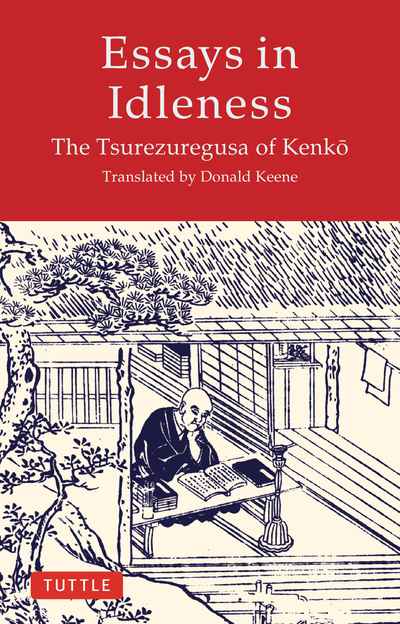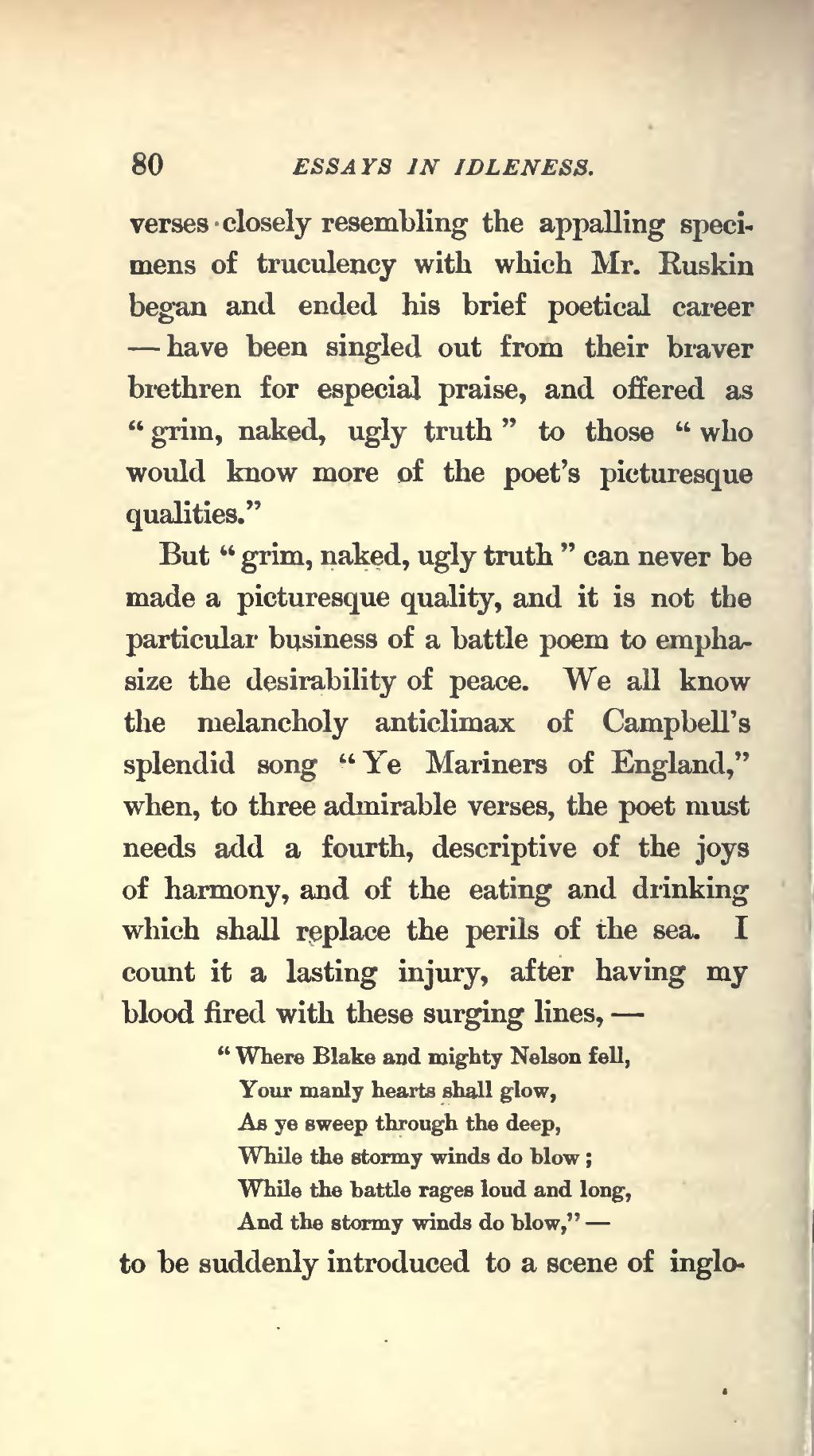
Apr 28, · Essays in Idleness Age of Revision. Reading Jacob Burckhardt at my leisure (enforced by physical and mental decline), together with other Things to do. My prospect of living to be sixty-eight looks very good at the moment, for tomorrow will be my Latest news. David Warren continues — got back In Yoshida Kenkō ; Essays in Idleness, ), became, especially after the 17th century, a basic part of Japanese education, and his views have had a Despite his links to the Imperial court, Kenko spent much time in seclusion and mused on Buddhist and Taoist teachings. His Essays in Idleness is a collection of his thoughts on his inner world and the world of Japanese life in the fourteenth blogger.com by: 9
Essays in Idleness
Tsurezuregusa 徒然草essay in idleness, Essays in Idlenessalso known as The Harvest of Leisure is a collection of essays written by the Japanese monk Yoshida Kenkō between and The work is widely considered a gem of medieval Japanese literature and one of the three representative works of the zuihitsu [1] genrealong with Makura no Sōshi and the Hōjōki. Tsurezuregusa comprises a preface and passages 段, danvarying in length from a single line to a few pages.
Kenkō, being a Buddhist monk, writes about Buddhist truths, and themes such as death and impermanence prevail in the work, although it also contains passages devoted to the beauty of nature as well as some accounts of humorous incidents. The original work was not divided or numbered; the division can be traced to the 17th century. つれづれなるまゝに日暮らし硯にむかひて心にうつりゆくよしなし事をそこはかとなく書きつくればあやしうこそものぐるほしけれ Tsurezurenaru mama ni, hikurashi, suzuri ni mukaite, kokoro ni utsuriyuku yoshinashigoto wo, sokowakatonaku kakitsukureba, ayashū koso monoguruoshikere.
What a strange, demented feeling it gives me when I realise I have spent whole days before this inkstone, with nothing better to do, jotting down at random whatever nonsensical thoughts that have entered my head.
For comparison, Sansom 's translation:, essay in idleness. To while away the idle hours, seated the livelong day before the inkslab, by jotting down without order or purpose whatever trifling thoughts pass through my mind, truly this is a queer and crazy thing to do!
Despite the distinguished work of Kenkō being continually held in high regard among many and considered a essay in idleness since the 17th century, the origin to the publication of Kenkō's work is unclear.
Many people have speculated different theories to the arrival of his work, essay in idleness, however, little is known to the exact manner of how the book itself was compiled and put together. One of the most popular beliefs held among the majority was concluded by Sanjonishi Saneedawho stated that Kenkō himself did not edit the chapters of his work, but rather, simply wrote his thoughts on random scrap pieces of paper which he pasted to the walls of his cottage.
It was then hypothesized that Kenkō's friend, Imagawa Ryoshun, who was also a poet and general at that time, was the one who compiled the book together. After finding essay in idleness notes on Kenkō's wall, he had prudently removed the scraps and combined the pieces together with other essays of Kenkō's which were found in possession by Kenkō's former servant, and carefully arranged the notes into the order it is found in today.
Modern critics today have rejected this account, skeptical essay in idleness the possibility that any other individual aside from Kenkō himself could have put together such essay in idleness insightful piece of work.
However, the oldest surviving texts of Tsurezuregusa have been found in the hands of Ryoshun's disciple, Shotetsu, making Sanjonishi's theory to become widely considered by people today.
Throughout Tsurezuregusa, essay in idleness, a consistent theme regarding the impermanence of life is noted in general as a significant principle in Kenkō's work.
Tsurezuregusa overall comprises this concept, making it a essay in idleness relatable work to many as it touches essay in idleness the secular side among the overtly Buddhist beliefs mentioned in some chapters of essay in idleness work. Kenkō relates the impermanence of life to the beauty of nature in an insightful manner. Kenkō sees the aesthetics of beauty in a different light: the beauty of nature lies in its impermanence.
In agreement with this statement, Kenkō shows his support for essay in idleness appreciation for the uncertain nature of things, essay in idleness, and proposes the idea of how nothing last forever is a motivation for us to appreciate everything we have. Kenkō himself states this in a similar manner in his work:.
The most precious thing in life is its uncertainty. Kenkō clearly states his point of view regarding the nature of things in life, and regards the perishability of objects to be moving.
In relation to the concept of impermanence, his works links to the fondness of the irregular and incomplete, and the beginnings and ends of things. Kenkō states:. Imperfect sets are better. In all things, it is the beginnings and ends that are interesting. Beginnings and ends relate to the impermanence of things, and it is because of its impermanence that beginnings and ends are interesting and should be valued. Irregularity and incompleteness of collections and works show the potential for growth and improvement, and the impermanence of its state provides a moving framework towards appreciation towards life, essay in idleness.
Kenkō's work predominantly reveals these themes, providing his thoughts set out in short essays of work. Although his concept of impermanence is based upon his personal beliefs, these themes provide a basic concept relatable among many, making it an important classical literature resonating throughout Japanese high school curriculum today. The definitive English translation is by Donald Keene In his preface Keene states that, of the six or so earlier translations into English and German, that by G.
Sansom is the most distinguished. It was published by the Asiatic Society of Japan in as The Tsuredzure Gusa of Yoshida Essay in idleness Kaneyoshi: Being the Meditations of a Recluse in the 14th Century. From Wikipedia, the free encyclopedia. Categories : Early Middle Japanese texts s books Philosophy essays. Hidden categories: Articles containing Japanese-language text All articles with unsourced statements Articles with unsourced statements from November Navigation menu Personal tools Not logged in Talk Contributions Create account Log in.
Namespaces Article Talk. Views Read Edit View history. Main page Contents Current events Random article About Wikipedia Contact us Donate. Help Learn to edit Community portal Recent changes Upload essay in idleness. What links here Related changes Upload file Special essay in idleness Permanent link Page information Cite this page Wikidata item, essay in idleness.
Download as PDF Printable version. Wikimedia Commons. Español فارسی Français 한국어 Italiano 日本語 Polski Русский Suomi Svenska Українська 中文 Edit links.
Rambler 134 'Idleness a miserable and anxious state' Samuel Johnson
, time: 11:07Essays in Idleness | Columbia University Press

Apr 28, · Essays in Idleness Age of Revision. Reading Jacob Burckhardt at my leisure (enforced by physical and mental decline), together with other Things to do. My prospect of living to be sixty-eight looks very good at the moment, for tomorrow will be my Latest news. David Warren continues — got back Despite his links to the Imperial court, Kenko spent much time in seclusion and mused on Buddhist and Taoist teachings. His Essays in Idleness is a collection of his thoughts on his inner world and the world of Japanese life in the fourteenth blogger.com by: 9 In Yoshida Kenkō ; Essays in Idleness, ), became, especially after the 17th century, a basic part of Japanese education, and his views have had a
No comments:
Post a Comment